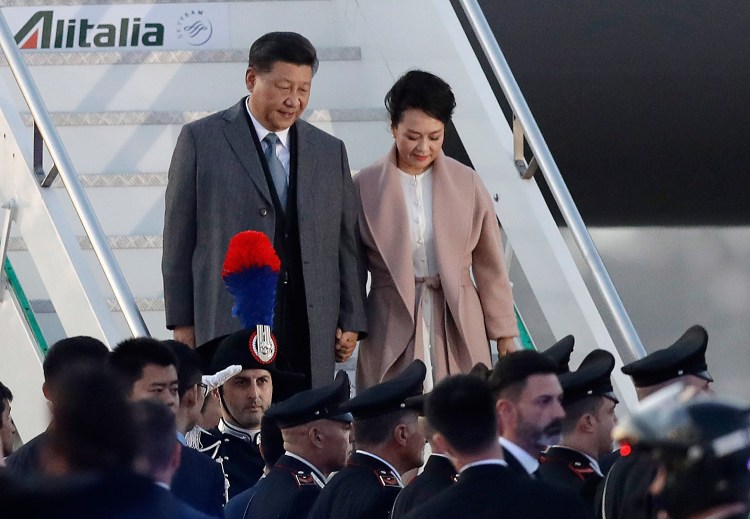MILAN — At the heart of Chinese President Xi Jingping’s visit to Rome that started Thursday is a key prize: a deal to make Italy the first major democracy to join China’s ambitious Belt and Road infrastructure initiative.
Italian Premier Giuseppe Conte has pledged to sign a memorandum of understanding with China on Saturday, despite Western concerns about Beijing’s growing economic clout. Italy’s allies and some within the country’s coalition government also think the deal could give China more political influence in Europe and the West.
But Xi’s visit, at the invitation of Italian President Sergio Mattarella, also has a broader aim of deepening trade and cultural ties. Conte has even suggested that Italy could play a role in easing trade tensions between China and the United States.
Xi and his wife, Peng Liuan, arrived at Rome’s main Fiumicino airport on Thursday evening. The Chinese president’s itinerary includes meeting with Mattarella and attending a wreath-laying at Italy’s monument for unknown soldiers on Friday.
Here’s a look what’s at stake in the visit, which ends on Sunday:
INFRASTRUCTURE
Italy’s signature on the ambitious Belt and Road infrastructure-building project would give legitimacy to a project that envisions overland and maritime routes connecting China with Europe, reviving the old Silk Road traveled by Marco Polo in the Middle Ages. The initiative encompasses about 60 countries through Asia and Africa to Europe.
Conte has dismissed concerns that signing the framework with China would downgrade Italy’s strategic ties with Europe and the United States, saying its focus was more commercial and on encouraging trade with China.
The White House has criticized the deal, saying it is weighted in China’s interests. Italy’s European allies have declined to sign a joint declaration on the “Belt and Road,” saying it lacks standards on financing and transparency.
While full details have not been released, it reportedly includes collaboration and investments in the northern Italian ports of Genoa and Trieste as well as roads, railways, airports and telecommunications.
“Our two countries may harness our historical and cultural bonds forged through the ancient Silk Road,” Xi wrote in the Corriere della Sera newspaper this week.
TECHNOLOGY
Key Italian officials have insisted that the issue of expanding Chinese company Huawei’s 5G network into Italy is not part of the Belt and Road memorandum.
The Chinese 5-G network is viewed with suspicion, mainly by the U.S. government, which says it could give Chinese security services a backdoor to snoop on consumers. The issue is a major source of tension between China and the U.S.
While European countries have balked at banning Huawei outright from participating in the creation of the new 5G network, one key member of Italy’s government, Interior Minister Matteo Salvini, shares the concerns, saying nothing in the memorandum can threaten Italians’ data.
CULTURE
Ahead of the visit, Xi noted that China and Italy are the countries with the largest number of UNESCO world heritage sites, sharing both cultural and tourism resources. He suggested that the two countries could form “twinning relationships” between world heritage sites and cooperate on art exhibitions, TV and movie production, language course and travel.
Mattarella said that the heritage of Italy and China both “arouse admiration around the world” and could help develop the economy.
The two countries are expected to soon announce the pairing of the Langhe, Roero and Monferrato wine region in Piedmont with China’s Honghe Hani rice terraces, while Verona and Hangzhou are to establish sister-city relationships.
Culture and tourism officials will be meeting Saturday on the sidelines of Xi’s visit.
TRADE
Conte said he aims to rebalance trade with China. Currently 1 billion Chinese consumers provide a market for nearly $15 billion in Italian goods, while Italy’s 60 million people buy $68 billion in Chinese-made products each year.
Italy’s undersecretary for economic development, Michele Geraci, says Italy lags its European partners in trade with China by 15 or 20 years, and that the aim is to increase Italian exports to China by 7 billion euros, putting Italy in line with France.
Mattarella said that Italy sees China “not only as an economic partner of prime importance, but also as a driver of global trade,” and a market for Italian technology and expertise in areas like environmental protection, food security, health services and machinery. He called for “open and transparent” trade with both countries acting “on an equal basis.”
Chinese Vice Foreign Minister Wang Chao said the Belt and Road deal would be beneficial for both countries.
However, Francois Godement, a specialist in Chinese politics at the Paris Institute of Political Studies, called such claims “bogus” because Chinese companies already have significant investments in Italy.
Copy the Story LinkSend questions/comments to the editors.



Success. Please wait for the page to reload. If the page does not reload within 5 seconds, please refresh the page.
Enter your email and password to access comments.
Hi, to comment on stories you must . This profile is in addition to your subscription and website login.
Already have a commenting profile? .
Invalid username/password.
Please check your email to confirm and complete your registration.
Only subscribers are eligible to post comments. Please subscribe or login first for digital access. Here’s why.
Use the form below to reset your password. When you've submitted your account email, we will send an email with a reset code.